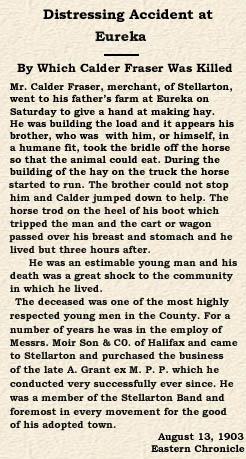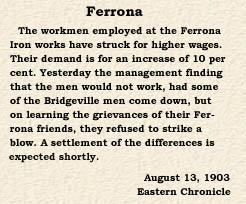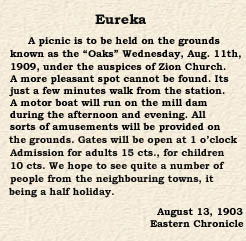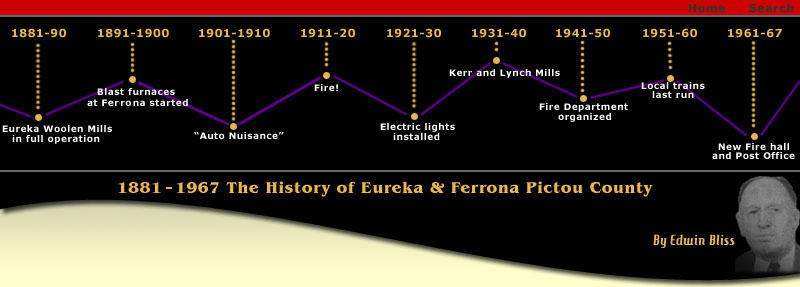1901- 1910
1901
The Oddfellows of Caledonia Lodge held an Anniversary Service in
Zion Church, Ferrona, on April 26, 1901.
On June 11, 1901, Elizabeth C. Falconer, daughter of Thomas
Falconer, became the bride of Thomas Robertson.
John D. Urquhart, merchant, was married to Emma McGee, on June 12,
1901. Both couples were married by Rev. A. M. Thompson.
1902
A Variety Concert, consisting of Instrumental and Vocal Solos –
Readings – Tableau, was held in Muir’s Hall, on March 11, 1902,
under the auspices of Zion Church. Proceeds $51.00.
Zion Church held an ice cream social and literary entertainment in
Muir’s Hall, on June 17, 1902, in aid of the Manse Fund.
In August, 1902, Mr. and Mrs. Robert Muir celebrated their Golden
Wedding Anniversary. Mr. Muir was born in Ayrshire, Scotland, in
1826. He came to this country when nine years of age, and lived in
Stellarton for a good many years. Mrs. Muir was a daughter of
Sylvanus Keith, of Stellarton. She was born in Scotland in the year
1822. She came to Hopewell with her parents when she was eight years
of age. The family later moved to Stellarton. Some years, following
their marriage, they moved to and became pioneers of the village,
now known as Eureka, where they continued to live. They had a family
of ten children, eight of whom were living in the year 1902. Among
the many useful and valuable gifts received was: a golden headed
cane, inscribed “to Father”, a gold ring from Mr. Muir to Mrs. Muir,
gold currency amounting to upwards of thirty-five dollars, a gold
brooch and locket, a gold lined ladle, gold lined egg cups and
spoons, and a beautiful specimen of gold in quartz.
In November, 1902, the bridge over the west branch of the East
River, at Eureka, was again raised some three or four feet. The
Blast Furnaces at Ferrona were doing excellent work after being
relined.
A Company composed of 14 shareholders took up the rights to land
from Eureka to Fox Brook and were boring for coal with a Government
diamond drill.
1903
In January, 1903, a horse and sleigh stolen by two Ferrona men, from
Mr. Gillespie, of Eureka, was recovered by policeman William Tupper.
In February, 1903, the Eureka Woolen Manufacturing Company, gave Mr.
F. L. Roop, an option to purchase their plant for $50,000. It was
proposed to organize a new company.
In April, 1903, Mr. John Urquhart, of Ferrona, purchased the
building owned by Calvin MacKenzie (MacKenzie’s Hall), intending to
tear it down and move it to Londonderry, for the purpose of erecting
and opening a General Store, where customers could buy anything
“from a brass cannon to a tallow candle”. His father, William
Urquhart, who is a partner of Urquhart & Son, would continue to do
business in Ferrona.

The boring operations for coal at Foxbrook, were reported down about
525 feet, in April, 1903. Two diamond drills were lost in the hole
and considerable money was spent trying to fish them out. The bits
cost $700.00.
A baseball match played At Ferrona on July 11, 1903, resulted in the
score of Eureka 15 – Hopewell 23.
In August, 1903, a fatal accident occurred at Eureka, when Calder
Fraser, of Stellarton, was killed by a horse starting to run and
pulling a haywagon over his chest and stomach.
 A strike occurred at the Ferrona Iron Works for a 10% increase of
wages, in August, 1903. A strike occurred at the Ferrona Iron Works for a 10% increase of
wages, in August, 1903.
On Christmas Day, December 25, 1903, Hugh D. Fraser, of Hopewell,
married Elsie J. McMillan of Ferrona.
1904
In March, 1904, J. Fred Falconer, Contractor, obtained the contract
for building an addition to the Station House at Eureka Siding.
The Ferrona Iron Works went out of Blast on June 1, 1904. The
Company obtained in 1894, the now well known Wabana iron ore
deposits of Bell Island, Newfoundland. Early in 1895, the Nova
Scotia Steel and Forge Company and the New Glasgow, Iron, Coal and
Railway Company were consolidated under the name of the Nova Scotia
Steel Company. In the succeeding few years, a great deal of
experimental work was undertaken at the Ferrona plant. Ores from the
different Nova Scotia districts had already been tried and now those
of Wabana were given a working test. This proved very successful and
a basic iron produced from which steel of a very good quality was
made. The various coals of the Province were also experimented with
and complete Washing and Coking tests made of each, and of different
mixtures. The information learned from this experimentation, at
Ferrona, and the very important facts obtained led to results of
extreme future importance in Nova Scotia.
In August, 1904, following the announcement that the Blast Furnaces
would be down for good, the old stand by, the Eureka Woolen Mills,
also became idle and the situation began to look very critical for
the village of Eureka and Ferrona. However the owners of the Woolen
Mills had not been idle. Their property and equipment needed
overhauling. Capital was solicited and found. The Company was
re-organized under the name of “The Nova Scotia Woolen Mills Ltd.,”
with M. H. Fitzpatrick, President; A. F. McCulloch, Vice-President;
A. Johnson Chisholm, Sec’y-Treas.; Board of Directors: Geo. E.
Munroe, Westville; J. C. Redmond, Montreal; H. B. McCulloch, New
Glasgow; and D. McIvor, Barney’s River. The premises were cleaned
up. Repairs made under Mr. Allan Haigh, a thorough tweed man, and a
former manager of Oxford Woolen Mills. A new boiler house was
erected and the system of driving the machines altered, by having
belt pulleys and belts substituted. The Company was going to
specialize in fine blankets, and this department would be under the
supervision of Mr. MacGillivray Grant, of Springville. The brand
name of “Eureka” would continue.
During the month of August, the morning local train, which
previously had just run from Stellarton, now was put into service,
leaving Hopewell at 6:15 a.m., and running to Trenton.
The Nova Scotia Woolen Mills, Ltd., formerly the “Eureka Woolen
Mills” got under way in October, and were now busy turning out
blankets. This product was considered even better that the excellent
goods they had previously put on the market.
In November, 1904, the loss of the Iron Works was being keenly felt
in the village, not only because of the employment it had provided,
but the smoke, the activity, the noise of the works and the puffing
of the big engines were all being missed. The sense of nostalgia was
very apparent.
In December, 1904, the Woolen Mills at Eureka were equipped with
electric lights, which made a vast difference in the lighting of the
interior and created a fine appearance of the Mills at night. The
people of the village were in the hopes of having one light placed
on the Iron Bridge, which was a very dark and dangerous spot.
1905
The year, 1905, became known as the year, with the winter of the big
snow. The snow started falling towards the end of the previous year
and kept piling up with storm after storm. May stories have been
told about the depth of the snow in this winter. Trains were buried;
transportation brought to a standstill; no automobiles in those
days, but even horses and sleighs were unable to get through the
drifts. Industry and activities of all kinds were kept to a minimum
during the winter.
In April, 1905, Mr. M. H. Fitzpatrick, President of the Nova Scotia
Woolen Mills, terminated his office in that capacity, it having been
learned that he had died in London, England, during the month of
February.
Mr. A. Johnson Chisholm, Sec’y-Treas. of the Nova Scotia Woolen
Mills, resigned his position in April, 1905, to accept an office
with the Nova Scotia Steel and Coal Co., at Sydney.
In June, 1905, Dr. Culton sold his practice to Dr. W. H. Robbins,
and left Ferrona to take a Post Graduate Course in New York, after
which he would settle in New Germany.
On October 31, 1905, Rev. A. M. Thompson married Mr. John A. Fraser
of Sydney, to Mary C. McMillan, of Ferrona.
1906
Following the closure of the Ferrona Iron Works, a sort of inertia
seems to have settled over the village. The Nova Scotia Woolen Mills
apparently continued to operate during this period in a
comparatively steady manner, but nothing occurred to seem worthy of
note. No doubt the usual social activities took place in the
village, nothing of importance could have taken place to consider
making a record of.
1907
In March, 1907, the Intercolonial Railway proceeded to take over the
Ferrona Junction to Sunny Brae Railway, also the line from New
Glasgow to Thorburn.
In June, 1907, Dr. W. H. Robbins, also takes over the property and
practice of Dr. J. F. MacDonald, of Hopewell, who moved to
Shubenacadie.
Following the erection of Zion Church, a long shelter was provided
along the line of the Scott property, for horses being driven to the
Church, there they had some protection from the icy blasts of winter
and were out of the direct rays of the hot sun in summer. This
shelter remained for many years before it was finally torn down.
About this time, automobiles began to make their appearance on the
roads of Pictou County. In 1907, the Legislature of Nova Scotia
passed an act regulating the running of Automobiles on the Public
Highways. It was called the “Motor Vehicle Act”. The maximum speed
permitted under this Act was 7 ˝ miles per hour, in towns and
cities, and 15 miles per hour in country districts. There were also
special regulations for reducing the speed on approaching bridges
and at curves in the road. It was also provided that any person,
walking or driving, by raising a hand, could compel a motor vehicle
to stop.
1908
In May, 1908, the Nova Scotia Woolen Mills were showing samples of a
new product, men’s underwear, which they were going to start
manufacturing. A large number of knitting machines were being
installed. The samples produced were splendid and a big scale
production was intended.
A Concert was given in Muir’s Hall, on November 25, 1908, under the
leadership of Miss Noble and the auspices of Zion Church. Mr. Joseph
N. Fraser, who had been organist of the Church for about seven years
was presented with a purse of gold, by the Chairman, Dr. Polley.
1909
In March, 1909, Mr. Stanley Fraser, cashier at the Intercolonial
Railway freight office, at New Glasgow, resigned his position and
entered into the Undertaking business at Eureka.
An Easter Concert was presented in Zion Church, Ferrona, on April
12, 1909, consisting of “Cantata Victory”, a Chorus of 60 children,
all dressed in white, solos, drills, etc. The concert was a complete
success, and great praise was expressed for the work of the director
and instructor, Mr. J. N. Fraser, who was assisted by Mrs. James
Gunn. Admission was 15 cents, the proceeds to go towards the new
organ.
In April, 1909, Messrs. McNaughton, Falconer and McKay, who were
operating a sawmill in the village, were being congratulated on
their venture into the lumber business. They had enjoyed a busy
winter for their sawmill.
 “A Picnic under the Oaks”, at Eureka, was held through the auspices
of Zion Church, on August 14, 1909. The motor boat was run on the
dam, with all sorts of other amusements. Admission – Adults 15
cents. Children – 10 cents. “A Picnic under the Oaks”, at Eureka, was held through the auspices
of Zion Church, on August 14, 1909. The motor boat was run on the
dam, with all sorts of other amusements. Admission – Adults 15
cents. Children – 10 cents.
Mr. and Mrs. Nathan Stiles, whose home was the property, now owned
by Mr. Clarence McDonald, held an auction sale on October 7, 1909.
They planned to remove to Cartwright, Manitoba, where they would
reside in the future. On October 5, 1909, the citizens of Eureka and
Ferrona, honored them prior to their departure, and presented Mr.
Stiles with a handsome amber-tipped silver mounted English briar
pipe, in a case. An excerpt from the address presented to him, read
as follows: “Being a pioneer of the place much of the burden fell
upon your taking an active part in building our school house and
acting as trustee, also acting on the building Committee of our
Church, and its Board of Management.”
The first Tennis Club, in the village, was organized during the
year, 1909. The Tennis Club presented a concert in Muir’s Hall, on
October 25, 1909, consisting of a Chorus, Songs and Readings by 12
flower girls. A play entitled, “The Peak Sisters”, patriotic drill
and chorus. The concert was again presented on November 12, 1909.
Admission – Adults 20 cents. Children 10 cents.
1910
During the year, 1910, little of special interest occurred in Eureka
and Ferrona, with the exception of the usual church activity and
social functions, the village pursued an even tenure of its ways.
However, in general, throughout Pictou County, the people continued
to be highly incensed at what they called “The Auto Nuisance.”
In 1908, a successful fight had been made to get a bill for the
regulation of Automobiles before the committee of the whole house.
The Amendment introduced to the Legislature, provided that the
Municipal and Town Councils would have the right to say on what days
of the week motor vehicles should be allowed to run. Under this
Amendment to the “Motor Vehicle Act”, automobiles were allowed to
run on the country roads of Pictou County, only on Mondays and
Fridays. This regulation continued until September, 1910, when the
measure came before the Governor-in-Council for its Annual Approval,
a change was made by which three days were given to the
Automobilists, by the addition of Wednesday as an open day. This met
with protests from all parts of the County. The Attorney General
explained to the Farmers’ Association that the extra day was made in
error, and was willing to comply with the wishes of the Pictou
Municipal Council.
1911-1920

|

